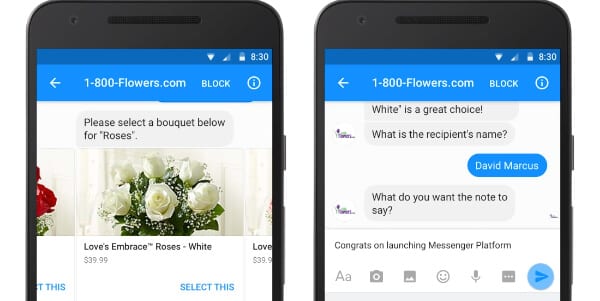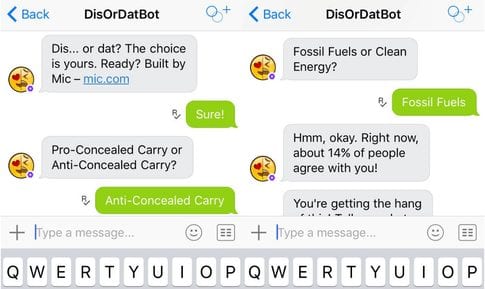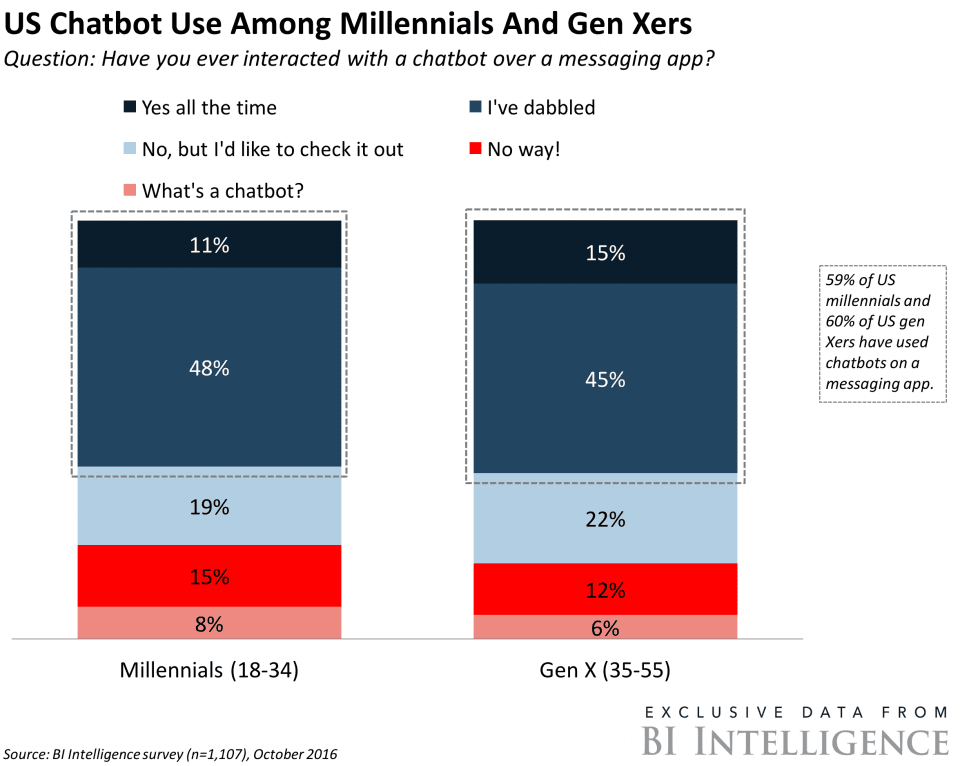If you want to build a business online, you’ll want to locate it where your customers are. You’ve heard about traditional mediums like blogs, forums, catalogs, social media platforms and maybe you even have an app for your company’s services. The important factors to consider are how much attention your customers pay to the sources and how much time they spend on each platform.
In early 2015 we saw a new instrument caught the market’s attention – chatbots. And while business messenger Slack dominated the chatbot revolution, everybody was waiting for Zuckerberg’s Facebook to show up with their chatbot platform. So we’ve been waiting patiently and the miracle finally happened at F8 conference triggering the chatbot boom, which is still continuing today.
Now you may wonder when this craze is going to die down. It’s hard to say, but what we know so far is that they’re here to stay and they’re going to keep on revolutionizing.
But wait, Bogdan, what’s the big deal about chatbots and why is everybody talking about them?! It’s all about capturing user attention, which nowadays is focused heavily on messenger apps. Furthermore, bots are using Natural Language Processing algorithms and AI layer to communicate with you, messaging apps are the best place for them to live. Let’s try to figure out why.
Imagine you’re a media company like The Wall Street Journal, Business Insider or CNN. You’re making revenue by selling advertising and publishing sponsored content, while your main expenses are creating and distributing content. So let’s think a bit about distribution.
The open rate for mobile messages is a near perfect 98 percent, which is exponentially higher than the 22 percent rate emails employ.
Source: Scripted
Soon we’ll start seeing chatbots everywhere. You can start interacting with a chatbot by sending a message. Try it with CNN chatbot.

Let’s look at a different scenario – you’re one of Facebook’s chatbot partners 1-800-Flowers.com and you basically need to sell flowers online. You have a number of phone and chat support staff, helping you to take care of most of the routine work part of which can be automated with chatbots (powered by self-learning AI component).
Have a question about building a conversational bot for your business? We’ve already made successful bots for media companies and e-commerce businesses. Let’s move forward with your project. Lets talk.
There are over 10,000 in Taobao and over 100,000 small merchants in TMall, two of the largest e-Commerce websites in China. Most of them have less than 10 people working for a company, but they’re obligated to hire an extra person just for answering online enquiries from customers. That’s the exact pain point chatbots are aiming to solve.
Alex Cheung, Founder & CEO @ Kami.AI
We see a huge potential in customer service where you answer frequently asked questions in an automated way that I think is a cost gain so companies will need fewer agents, fewer customer service agents who are typing the very same answers to everybody.
Ákos Deliága, CEO & Co-founder @ Talk-A-Bot
In the first two months after introducing its Facebook chatbot, 1-800-Flowers.com reported that more than 70 percent of its Messenger orders were from new customers. These new customers were also generally younger than the company’s typical shopper, as they were already familiar with the Facebook Messenger app.

Chatbots Aren’t Just Built For Millennials
Data from Business Insider shows us that chatbots are pretty popular amongst users from 18 to 55 years.
How Exactly Are Chatbots Going To Make Money
With payments integrated directly into the chatbot, you can use it in retail, consulting, hotel reservations and many more. Here’s a list of business models that would benefit from the application of chatbots.
Pure retail sales bots
Retail is one of the most straightforward experiences you will find amongst chatbots. You can imagine stores like Wal-Mart, Harry’s, Target and Amazon creating bots where people can ask them if they sell something like “Shampoo” or “Hammer” and the bot responds with prices and a “Buy now” button. Take Amazon’s Alexa for example: right now you can ask Alexa to re-order the goods you bought last week on Amazon! The user will make the purchase directly through a chat with the bot and it will act in a similar way to a transaction from a typical website, but it will be done in the palm of their hand.
We are able to learn quickly from the orders history, so we can turn the bot into a productivity bot. Based on the individual user shopping habits the bot is able to predict what the user would buy, so the cart will already be prefilled with products the bot will pick.
Cloderic Mars, CTO @ craft.ai
Bots + sponsored & native content
Native content and advertising is a trend that has been soaring over the past few years thanks to the likes of BuzzFeed, VICE, Huffington Post, Business Insider and more. Native or Sponsored content is a model in which brands pay to have their content distributed by media companies directly into their channels in a way that is often viewed as content created by the media outlet rather than a brand.
Now imagine you’re using a Cooking Bot. While the bot will tell you that swapping Cumin for Coriander is okay in a certain recipe through its native function , it will also send you an article that talks about “5 Exotic Meat Recipes That Will Please Your Guests.”
Bots for research
Wondering what millennials are thinking about the Presidential Election?
There are bots that you can pay to do the research for you. Bots like DisOrDatBot are already asking people simple this or that questions, as you can see in the example above.

Now, imagine you’re an event planner and are trying to determine which music act you should try to book for your city. Rather than using an expensive research firm or inaccurate focus group, you can run a research campaign with DisOrDatBot and ask users in your city whether they prefer Radiohead or Nickelback.
Bots for lead generation
Lead generation businesses are like the Wild West of the online world.
- Create a landing page.
- Acquire targeted leads.
- Sell leads to producers.
- Profit.
In the near future we will see chatbots that act as lead generation businesses with an initial focus on content. The chatbots will deliver insights and information to users who are looking for advice about home ownership, insurance, weddings or finances and then pass along user information to various businesses who sell services and products that line up with the content they’re delivering.
For example, imagine you’re talking to the “Shopping Bot” and start engaging in a conversation about home buying. As the discussion continues, the bot gathers information like the amount of cash you have for a down payment, where you want to live, whether you’re employed and whether it’s your first home. After building this relationship, the bot asks you:
Could I pass this along to someone to get in touch?
You agree and the bot then passes your information along to a Real Estate company in your area. The Real Estate company follows up with you the next day and the bot company gets paid for the lead.
One of the greatest added values of chatbots is using them for generating prospects. You can reach your potential clients directly where their attention is (messengers) and present them your newest products, services or goods. When a customer would like to purchase a product/service, he/she can make the purchase within the chatbot, including the payment process. Bots, like 1-800flowers.com, eBay, Fynd have already proved that.
Julien Blancher, Co-Founder @ Recast.AI
Here’s the updated lead generation process, but using a bot:
- Company Creates Lead Generation Bot.
- Bot Validates The Lead.
- Lead Passed To Company.
- Commision Paid By Company To Bot.
Cost per conversation/task
People want advice and are always willing to pay for it.
As bots become more sophisticated, I expect people will be willing to pay to have conversations with the bots that can help them with miscellaneous challenges in life. For example, you could talk to the “Oprah Bot” if you needed life advice, the “Mechanic Bot” for information on your car or the “Marriage Bot” if you wanted anonymous marriage counseling.
Marriage counselors can charge anywhere from $75 to $200 or more per hour depending on where you live, the experience of the therapist, and the type of setting.
Ready to build a conversational bot for your business? We’ve already made successful bots for media companies and e-commerce businesses. Let’s move forward with your project. Contact Us.
Summary
This is just the beginning. What we’ve looked at is just a snapshot of a technology which is capable of changing not only small businesses, but also major industries into slick, effective mechanisms. Artificial intelligence will become smarter, the response of natural language processing will become faster and many processes will become much easier, like arguing with Comcast for example. Just kidding.
Please share your thoughts in the comments section.
Illustration by Alina Kropacheva

